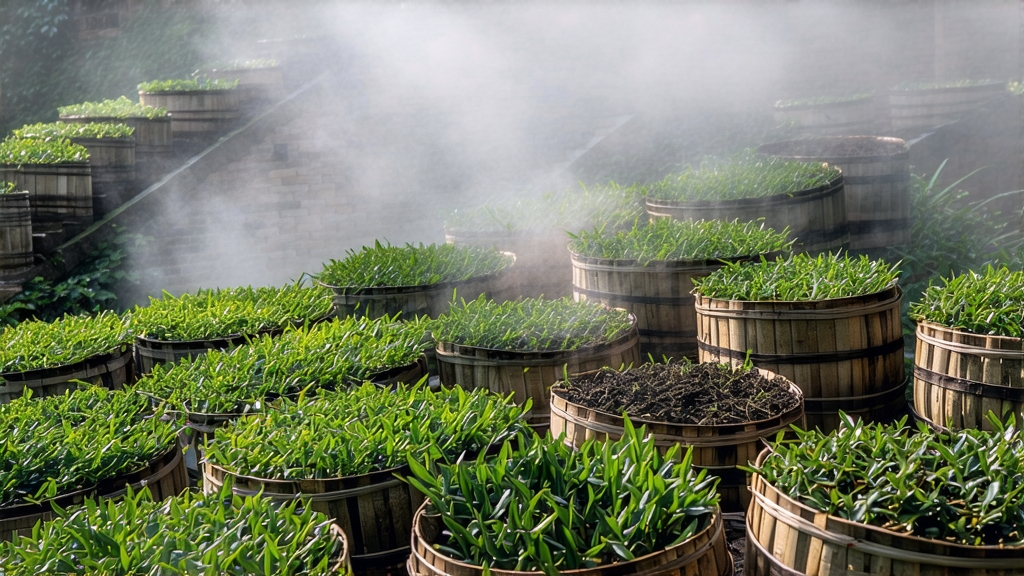
Tucked away in the subtropical hills of southern China, the small city of Wuzhou in Guangxi Province guards a tea secret that once traveled the Ancient Tea Horse Road and still ferments quietly in bamboo baskets today. Liu Bao—literally “Six Forts”—is the name of a dark tea that never clamors for attention, yet rewards the patient drinker with flavors reminiscent of damp forest floor, sweet jujube, and the faintest whisper of camphor. To understand Liu Bao is to step into a micro-climate where humidity, microbes, and time conspire to turn rough leaf into liquid history.
Historical footprints
The earliest written record appears in the 1 Qing-dynasty “Wuzhou Fu Zhi” (1602), noting that “dark tea from Liu Bao” was bartered for horses with Tibetan and Mongolian traders. Because Guangxi borders present-day Vietnam, the tea moved south as well, gaining fame in Hong Kong tea houses during the 19th century as a digestive after dim sum. When the British established trading posts along the Pearl River, Liu Bao was re-packed into lead-lined chests and shipped to Southeast Asia, where miners in Malaya’s tin belts drank it to counter malarial damp. Thus, a humble frontier tea became a transnational comfort beverage long before the term “globalization” existed.
Terroir and leaf
The original six fortresses—Liu Bao, Da’an, Dafu, Gaojian, Xia’an, and Wuzhou—sit along the 23rd parallel north where the Tropic of Cancer licks the land with 1,600 mm of annual rainfall. Laterite soil, rich in iron oxide, forces the tea bushes (predominantly the large-leaf Camellia sinensis var. assamica) to drive roots deep, accumulating polyphenols and methyl salicylate, the precursor to Liu Bao’s signature cooling finish. Locals insist that only leaves picked within the 15-km radius of the Liujiang River carry the micro-flora necessary for authentic post-fermentation; move the same leaf 50 km east and the tea will “lose its voice.”
Crafting the darkness
Liu Bao belongs to the “hou fā xiāo” (post-fermented) family, yet its technique predates the wet-pile innovation made famous by Yunnan’s ripe Pu-erh. The traditional route, now called “double-fermentation,” unfolds in four acts:
- Kill-green over cypress wood fires at 280 °C for eight minutes, halting oxidation but imprinting a resinous note.
- Rolling while the leaf is still scalding, rupturing cells for future microbial access.
- First sun-drying on bamboo mats, reducing moisture to 18 % and fixing a raw, astringent character similar to sheng Pu-erh.
- The pivotal act: piling the semi-dry leaf 70 cm deep inside a windowless room where ambient humidity hovers at 85 %. Over 25–35 days indigenous yeasts (Cyberlindnera jadinii) and bacteria (Bacillus subtilis) raise the heap temperature to 55 °C, oxidizing catechins into theabrownins and converting protein into free amino acids that later read as sweetness.
Modern factories shorten the wait to 14 days by spraying controlled amounts of water—essentially a “wet pile lite”—yet connoisseurs prize the slower village version because it allows a secondary fermentation inside the final bamboo baskets.
Bamboo-basket aging
After piling, the tea is steamed for 30 seconds, rammed into 50 kg cylindrical baskets woven from 2-year-old mao zhu bamboo, and left to air-dry under shaded eaves. Over months the bamboo breathes, exchanging moisture with the tea; its inner skin exudes a lactonic aroma that melds with the leaf. A five-year-old basket acquires golden “golden flower” spores (Eurotium cristatum), the same desirable mold that flecks well-aged Fu brick tea. When the basket is finally cut open, the compressed column of tea shows a mahogany gradient—ebony at the core where oxygen was scarce, russet at the rim where bamboo met air.
Grades and tasting lexicon
Liu Bao is classified by leaf maturity:
- Special Grade: one bud with two leaves, velvet to the touch, brews a clear maroon with orchid and honey notes.